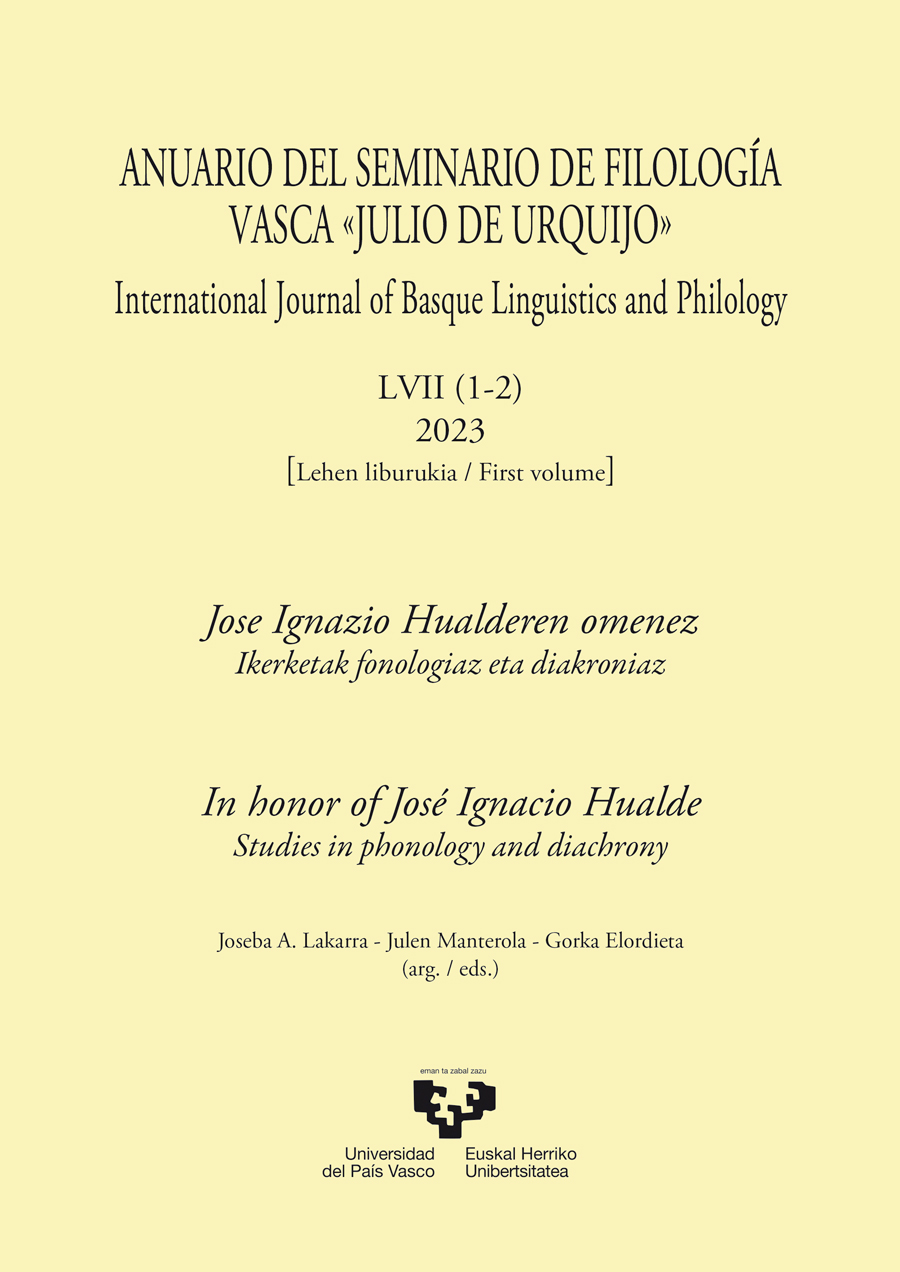Palatal assibilation before [w]? The case of Armenian, Saka, and Luwian
##plugins.themes.bootstrap3.article.main##
##plugins.themes.bootstrap3.article.sidebar##
Laburpena
Three branches of Indo-European —Luwian, Armenian, and East Iranian (Khotanese) Saka— seem have undergone asssibilation of PIE palatal-prevelar stops before [w], a development contrasting with the general outcome of these stops in Armenian and Saka, and with their apparent outcome before [- front] vocalic segments in Luwian. So far, no principled phonetic or phonological explanations for this behavior have been proposed. I show that the developments in Saka and Armenican can be accounted for in terms of a crosslinguistic tendency for the high-vocalic labiovelar glide w, whether full segment w or nonsegmental offglide w, to assimilate to a following y or front vowel by becoming labiopalatal segmental ɥ or offglide ɥ, which following a common trend is unrounded to y or y and then palatalizes and assibilates the preceding stop. This account is not applicable to Luwian for which a general assimilation of palatal-prevelar before non-low vowels seems the best solution. The similarity between Armenian and Saka on one hand and Luwian on the other, thus, is accidental, and we must conclude that similar outcomes can be produced by very different historical developments.
Nola aipatu
##plugins.themes.bootstrap3.article.details##
Cantera, Alberto. 2017. The phonology of Iranian. In Jared Klein, Brian D. Joseph & Matthias Fritz (eds.), Handbook of comparative and historical Indo-European linguistics, 481-503. Berlin: de Gruyter Mouton.
Emmerick, Ronald E. 1989. Khotanese and Tumshuqese. In Rüdiger Schmitt (ed.), Compendium linguarum iranicarum, 204-229. Wiesbaden: Reichert.
Hock, Hans Henrich. 2009. Labiopalatalization in Indo-European languages. In Stephanie Jamison, H. Craig Melchert & Brent Vine (eds.), Proceedings of the 20th Annual UCLA Indo-European Conference, 69-78. Bremen: Hempen.
Hock, Hans Henrich. 2015. The northwest of South Asia and beyond: The issue of Indo-Aryan retroflexion yet again. Journal of South Asian Languages and Linguistics 2(1). 111–135.
Hock, Hans Henrich. 2021. Principles of historical linguistics, 3rd edn. Berlin & Boston: de Gruyter Mouton.
Korn, Agnes. 2016. Iranian. In Hans Henrich Hock & Elena Bashir (eds.), The languages and linguistics of South Asia: A comprehensive guide, 51-66. Berlin & Boston: de Gruyter Mouton.
Kortlandt, Frederik. 1980. On the relative chronology of Armenian sound changes. First International conference on Armenian Linguistics: Proceedings, 97-106. Delmar: Caravan Books.
Kümmel, Martin Joachim. 2007. Konsonantenwandel: Bausteine zu einer Typologie des Lautwandels und ihre Konsquenzen für die vergleichende Rekonstruktion. Wiesbaden: Reichert.
Kümmel, Martin Joachim. 2008. Mitteliranisch I: Khotansakisch. https://www.academia.edu/1748443/Introduction_to_Khotan_Saka_in_German_
Kümmel, Martin Joachim. 2016. *sya- im Indoiranischen: Zahlwort oder Demonstrativum? In Andrew Myles Byrd, Jessica DeLisi & Mark Wenthe (eds.), Tavet tat satyam: Studies in honor of Jared S. Klein, 179-190. Ann Arbor: Beech Stave Press.
Liljencrants, Johan & Björn Lindblom. 1972. Numerical simulations of vowel quality systems: The role of perceptual contrast. Language 48. 839–862.
Lipp, Reiner. 2009. Die indogermanischen und einzelsprachlichen Palatale im Indoiranischen, 1: Neurokonstruktion, Nuristan-Sprachen, Genese der indoarischen Retroflexe, Indoarisch von Mitanni. Heidelberg: Winter.
Mayrhofer, Manfred. 1986-1992. Etymologisches Wörterbuch des Altindoarischen, 2 vols. Heidelberg: C. Winter.
Meillet, Antoine. 1936. Esquisse d'une grammaire comparée de l'arménien classique, 2nd ed. Vienne: Imprimerie des PP. Mékhitaristes.
Melchert, H. Craig. 1993. Historical phonology of Anatolian. Journal of Indo-European Studies 21. 237-257.
Melchert, H. Craig. 2012. Luvo-Lycian dorsal stops revisited. In Roman Sukač and Ondřej Šefčík (eds.), The sound of Indo-European 2: Papers on Indo-European phonetics, phonemics and morphophonemics, 208-218. München: Lincom Europa.
Melchert, H. Craig. 2020. Hittite historical phonology after 100 years (and after 20 years). In Ronald I. Kim, Jana Mynářová, and Peter Pavúk (eds.), Hrozný and Hittite: The first hundred years, 258-276. Leiden/Boston: Brill.
Osthoff, Hermann. 1901. Etymologische Parerga. Leipzig: Hirzel.
Schmitt, Rüdiger (ed.). 1989. Compendium linguarum iranicarum. Wiesbaden: Reichert.
Schmitt, Rüdiger. 1989. Altiranische Sprachen im Überblick. In Rüdiger Schmitt (ed.), Compendium linguarum iranicarum, 25-31. Wiesbaden: Reichert.
Simon, Zsolt. 2015. Altassyrisch ḫazuanum: Noch eine anatolische Entlehnung. NABU: Nouvelles Assyriologiques Brèves et Utilitaires 2015(3). 103-105.
Simon, Zsolt. 2016. Die Etymologie des luwischen *ḫazzuwanni-. 2. Indogermanisches Forschungskolloquium, Würzburg, March 31, 2016.
Sims-Williams, Nicholas. 1998. The Iranian languages. In Anna Giacalone Ramat & Paolo Ramat (eds.), The Indo-European languages, 125-153. London & New York: Routledge.
Skjærvø, Prods Oktor. 2009. Old Iranian. In Gernod Windfuhr (ed.), The Iranian languages, 43-195. Oxford & New York: Routledge.

This work is licensed under a Creative Commons Attribution-NonCommercial-NoDerivatives 4.0 International License.
Lan hau Creative Commons Aitortu-EzKomertziala-LanEratorririkGabe 4.0 Nazioartekoa lizentzia baten mende dago.


